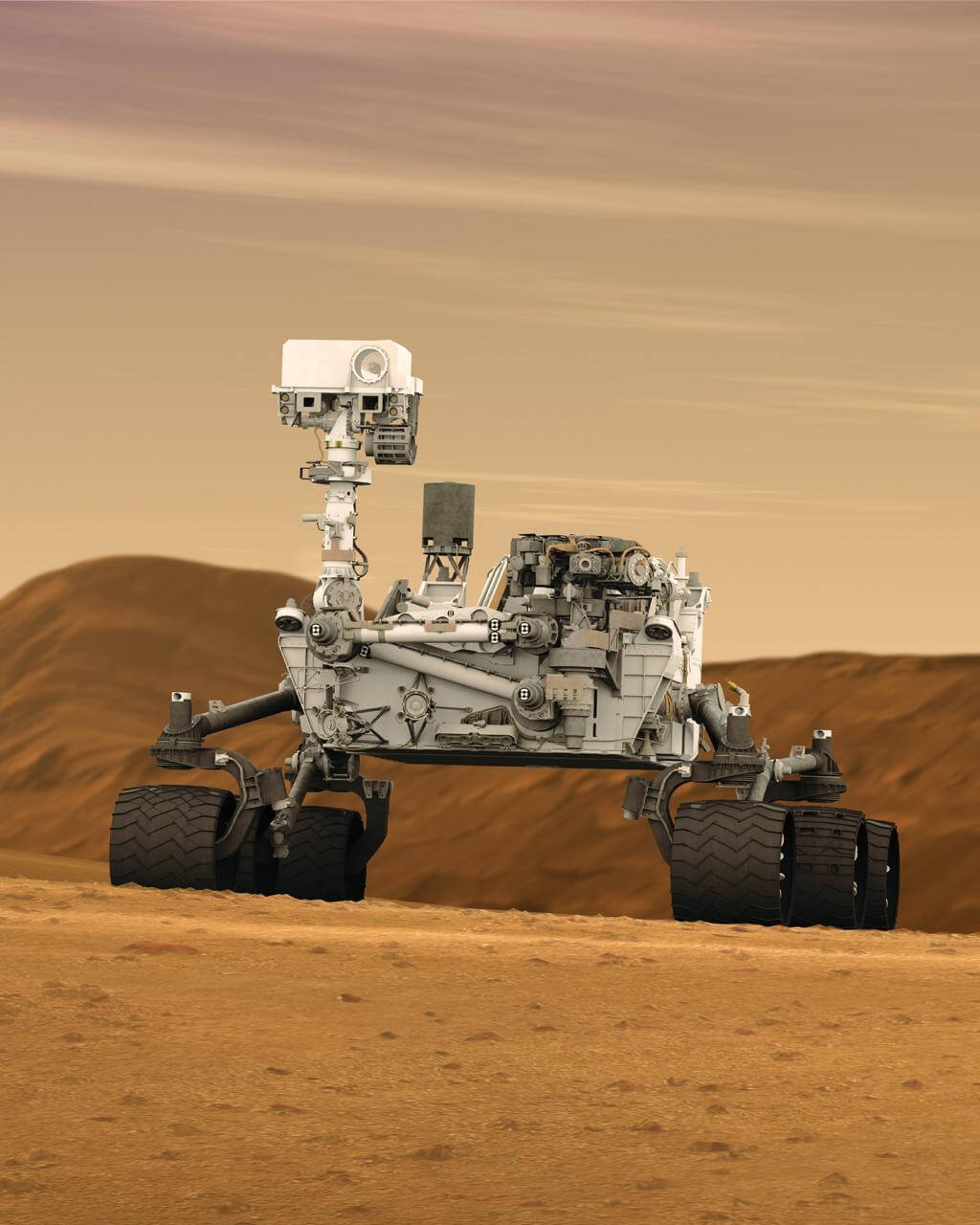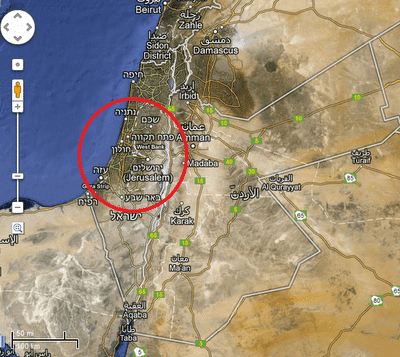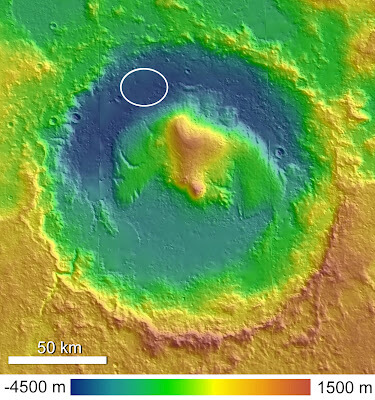Summary of the previous episodes: On Monday at 08:31 am (Israel time) the Curiosity rover will land on the surface of Mars. The landing operation, which is probably the most complex autonomous operation ever carried out, certainly the most complex in the field of planetary research, has been described in detail in the previous records. This time we will deal with the landing site

As I already wrote in one of the previous entries, the "uncertainty" zone of the landing in previous missions to Mars was an ellipse with dimensions of approximately 100 kilometers, with small changes depending on the mission conditions. This fact forced the planners to find a huge area on the surface of Mars that is completely flat, and empty of rocks. There are not many such areas, and when there are, they are far from the scientifically interesting places. Geologists find the information about the history of the soil in places where the soil has undergone changes in the past, so it will be anything but flat.
Therefore, Curiosity's planning required placing the rover in a small and precise "uncertainty" zone, so that it would be possible to choose an "interesting" landing site.
Curiosity's landing system is capable of landing the rover inside an ellipse that measures only 7 by 20 kilometers. It does this by controlling the course of entry into the atmosphere, that is, offsetting errors in position due to inaccuracies at the point of entry, or unpredictable weather on the way down.
The small ellipse made it possible to choose Gale Crater, which is in the southern hemisphere of Mars, close to the equator, as a landing site. Gale Crater, like most of the Martian terrain, has never had visitors from Earth.
What is special about Gale Crater?
Gale Crater is a huge crater, 150 kilometers in diameter, which was created by the impact of a large asteroid on Mars at least 3 billion years ago. It was difficult for me to imagine the size relative to the distances I know, so I drew a circle with a diameter of about 150 kilometers on the map of Israel, and this is how it looks:

The depth of the crater varies between 2 and 3 kilometers, and in its center rises Mount Sharp, which is 5-6 kilometers high relative to the bottom of the crater. Curiosity will land in the lowest area of the crater, at the foot of the mountain.
Gale Crater is the lowest area in its entire environment, so it is likely that during the period when there was water on the surface of Mars, it would have drained from the entire area and settled at the bottom of the crater. Therefore, we expect to find there products of chemical and physical activities that only occur in a wet environment.
The sedimentary layers that are expected to be found at the base of Mount Sharp are a key to the history of the environmental conditions that prevailed at this location. Curiosity will move towards the mountain and even climb the gentle slopes at its base, and survey with its variety of geological instruments the types of rock and soil found there.

Curiosity is equipped with tools and sampling and measuring devices, which characterize a geologists' expedition that goes out into the field, along with their laboratory (which they usually prefer to leave elsewhere).
Curiosity's mission is defined as 98 weeks, which is one Martian year. During this time, it will tour interesting areas within a range of tens of kilometers from the landing point, and through its 10 scientific investigation instruments will collect information on the chemistry of the soil and air, on environmental conditions such as pressure, humidity, temperature and radiation from space and the ground, and will look for organic materials that may indicate the potential for life in the past on mars
It should be emphasized that Curiosity is not equipped to identify living creatures. It is not able to detect any biological processes. It is also equipped with the means to detect an environment with the potential to form life, such as water, complex organic molecules and energy in the form of radiation or heat. Curiosity will focus on trying to locate and classify organic molecules (compounds containing carbon), as well as chemical elements necessary for life such as nitrogen, phosphorus, oxygen and sulfur. In addition, it also has the ability to identify different isotopes of these elements.
Curiosity's scientific goals are an understanding of the biological potential of the exploration area by evaluating the inventory of organic compounds and their origin, characterizing the geology around the rover and chemical, isotopic and mineralogical exploration on the surface of the ground and even slightly below them, studying planetary processes such as the development of the atmosphere on Mars, and measuring and characterizing the types of radiation emitted from the ground, the intensity of cosmic radiation and the particles coming from the sun. The last goal (radiation measurements) is intended for a human expedition to Mars, somewhere in the future.
Landing tomorrow. On Monday, from 08:00 in the morning at the latest, I will start monitoring the media channels dealing with the landing, and will update the "Critical Mass" Facebook page with regular reports.
If you are interested in being updated in real time, participating in the conversation and asking me questions, register atFacebook page right now.
First entry in the Curiosity series: How hard is it to land on Mars?
Second entry in the Curiosity series: Dive into the atmosphere of Mars
Part Three: End of Curiosity's landing phase

16 תגובות
No. Ben Ner,
There is no need for research, because craters with a mountain in the center have been found on the Earth and the Moon.
You can also throw a stone into water and see the same phenomenon.
Regarding soil, there is a laboratory in the USA where they shoot a projectile at the speed of a meteor reaching Israel (about 40,000 km/h) into standard soil and see the same phenomenon.
As for Martian life, there is that famous meteorite with that microscopic "worm" that turned on all the scientists.
There is a theory that life came to Israel through meteors that fell from space.
for a professional snooze
To your question why look for life specifically on Mars, the answer is divided into two
1. Mars is the nearest planet that…..2. It is possible, technologically, to investigate it.
To summarize this point, research what you can.
According to your claim at the end of your response that "...everything else is conjecture, speculation and guesswork"
You are absolutely right but…
There is nothing new in this. This is one of the two ways in which science goes "from then to forever".
One: science is looking for an explanation for a new phenomenon.
The second: science develops a theory and tries to deny or confirm it.
Ruby
1. Thank you for your answer regarding the formation of the mountain at the bottom of the crater. Your answer is also about what I thought.
What is interesting is whether there are research findings that confirm the explanation you gave.
2. To your question why one seeks life in a crater, the answer is very simple. most likely
For inventions of life in the past and finding remains of life today is, in the place where there was the most water, the most time.
And this is probably in the largest and deepest craters.
There are marks on the ground that only running water can make.
I didn't understand why at all think that it was Mars of all the stars that had life.
Chotsamza about 3 billion years, in my estimation it is actually 2.3 billion years plus or minus half a million years.
Indeed, there is no doubt that the water will flow to the lowest point, only that when there is no water it will flow nowhere.
The only science in this article is the fact that the rover landed. Everything else is conjecture, speculation, and guesswork.
The mountain in the center of the crater is the product of a meteor impact.
The force of the impact was probably very great so that a hole the diameter of the crater was created, some of the sand turned into shards of glass, gases and liquids and the center of the morning rose up just like in the advertisement photos where you throw a solid there into milk and get a kind of crown with a conical mountain in the center.
You can find there quartz and glass shards and rocks from 4-5 billion years ago and of course carbon remains from the water period that was there.
I don't understand why they are looking for life in the exact place where an asteroid hit.
If at least 3 billion years ago there was life in this area, then undoubtedly the asteroid with its radiation erased the chance of their survival and preservation. The surrounding area is the interesting area, correct me if I'm wrong
By the way, you asked the geology experts
The mountain at the bottom of Gale Crater
Is it a direct result of the impact of the asteroid that created the crater
Or the result of a late volcanic eruption?
There are indeed eight engines in the corners of the vehicle, but in the later phase of the landing, as the weight of the spaceship decreases (due to the depletion of fuel), the four facing down are turned off and the four facing to the side are left to work.
A live broadcast of the landing (or at least NASA people biting their nails) can be seen on NASA TV:
http://www.nasa.gov/multimedia/nasatv/index.html
Where can those who do not wish to register for Facebook get updates in real time?
Ori
There are 4 pairs of engines (in the rover's landing gear) so it is possible that if one engine fails then its partner covers up the failure.
Did they take security factors here? It seems that during the critical phase of the landing, 4 rocket engines are used located at the four ends of the rover, what will happen if one of them fails? Will the three remaining engines manage to keep the rover balanced?
The vehicle's energy source is indeed nuclear (I don't know if it actually meets the criteria of a "nuclear reactor"). First, this vehicle probably has many needs than solar collectors in a reasonable area can provide. Second, solar collectors tend to suffer from dust accumulation and a decrease in their effectiveness, as happened to Spirit and Opportunity. On the other hand, the length (half) of the life of the nuclear source will probably affect the life of the vehicle, and it will not wander there for countless years.
The landing ellipse is indeed smaller than that of previous missions, and it is due to improvements in the system's navigation (compared to the systems used in earlier landings). I guess the guidance rockets in the phase of entering the atmosphere also have a part in it.
per person:
As you get closer to the target, you can mark a smaller area where the damage will be.
Below the topographic image is written "The ellipse marks the landing site at the time of launch. Today she is much smaller"
Can anyone explain?
Why did its size suddenly change?
The lander's energy source is a nuclear reactor to the best of my memory and not solar collectors. Is that true?
Thanks for the coverage!